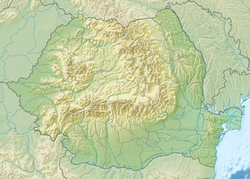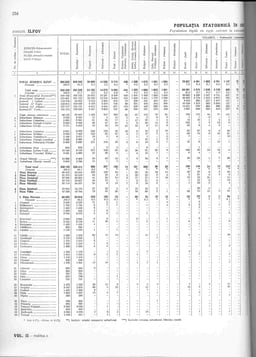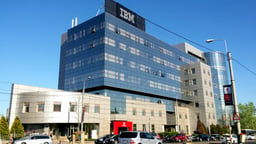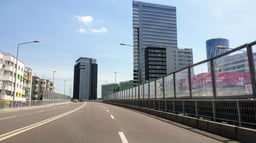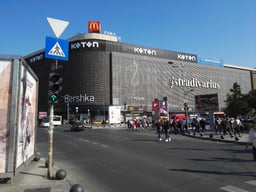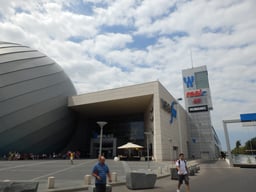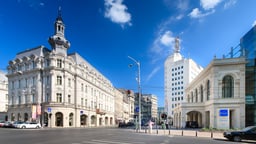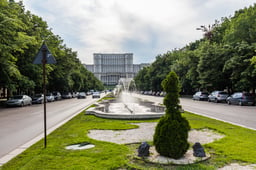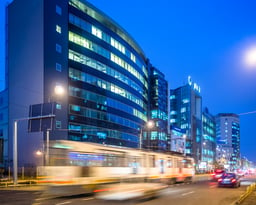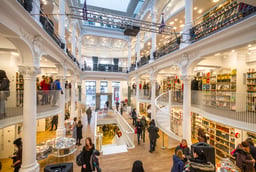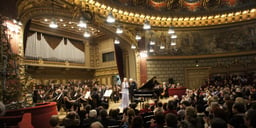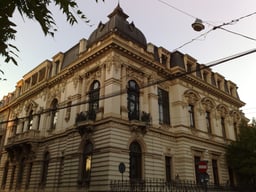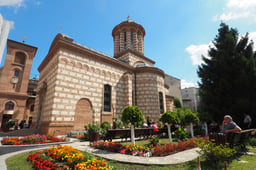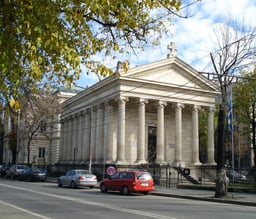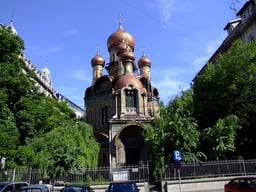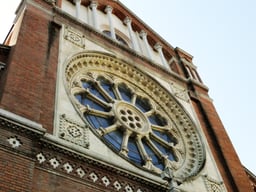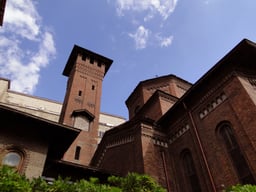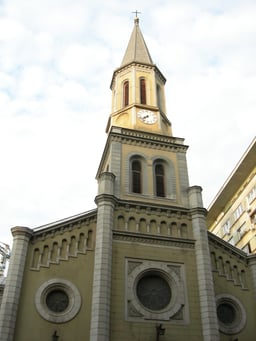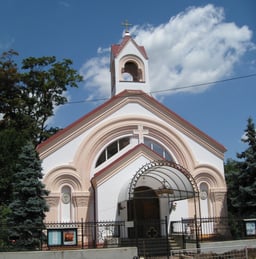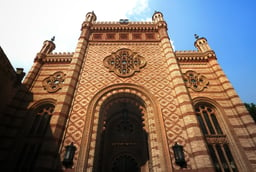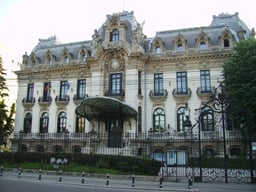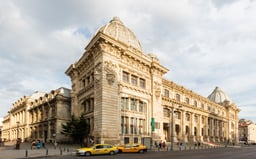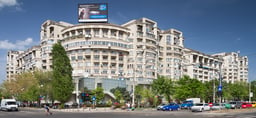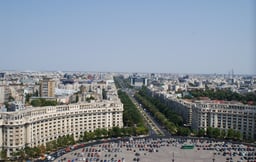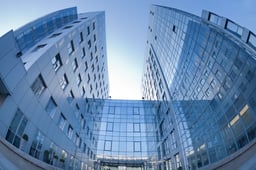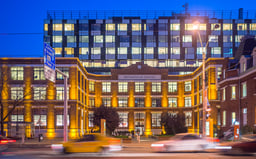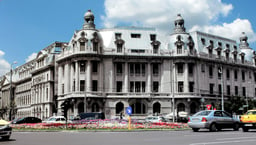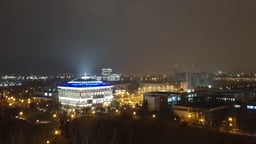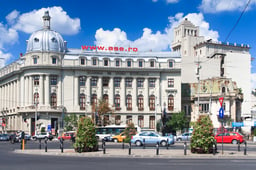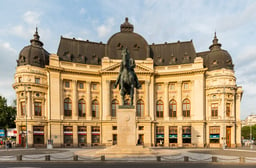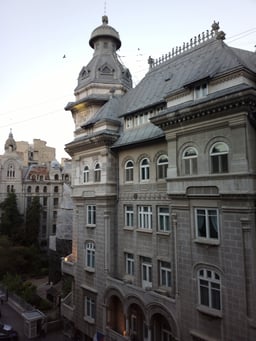Bucharest

Bucharest

Bucharest București | |
|---|---|
Capital city | |
| Nicknames: | |
| Motto(s): Patria și dreptul meu (The Homeland and my right) | |
| Coordinates:44°25′57″N 26°6′14″E [125] | |
| Country | Romania |
| County | Nonea |
| First attested | 1459 |
| Government | |
| • Mayor | Gabriela Firea (Social Democratic Party)[2] |
| Area | |
| • Capital city | 228 km2(88 sq mi) |
| • Urban | 285 km2(110 sq mi) |
| Elevation | 55.8–91.5 m (183.1–300.2 ft) |
| Population (2011)[6] | |
| • Capital city | 1,883,425 |
| • Estimate (2016)[7] | 2,106,144 |
| • Rank | 1st in Romania (6th in EU) |
| • Density | 9,237/km2(23,920/sq mi) |
| • Metro | 2,412,530[5] |
| Demonyms | Bucharester (en) bucureștean, bucureșteancă (ro) |
| Time zone | UTC+02:00 (EET) |
| • Summer (DST) | UTC+03:00 (EEST) |
| - Per capita (2018) [8] | €22,365 (Nominal) €43,200 (PPP) |
| HDI (2017) | 0.914[9] –very high |
| Website | pmb.ro [126] |
Bucharest (UK: /buːkəˈrɛst/, /bʊk-/; US: /ˈbuːkərɛst/; Romanian: București [bukuˈreʃtʲ] (listen)) is the capital and largest city of Romania, as well as its cultural, industrial, and financial centre. It is located in the southeast of the country, at 44°25′57″N 26°06′14″E [127] , on the banks of the Dâmbovița River, less than 60 km (37.3 mi) north of the Danube River and the Bulgarian border.
Bucharest was first mentioned in documents in 1459. It became the capital of Romania in 1862 and is the centre of Romanian media, culture, and art. Its architecture is a mix of historical (neo-classical and Art Nouveau), interbellum (Bauhaus and art deco), communist era and modern. In the period between the two World Wars, the city's elegant architecture and the sophistication of its elite earned Bucharest the nickname of "Little Paris" (Micul Paris).[10] Although buildings and districts in the historic city centre were heavily damaged or destroyed by war, earthquakes, and Nicolae Ceaușescu's program of systematization, many survived and have been renovated. In recent years, the city has been experiencing an economic and cultural boom.[11] In 2016, the historical city centre was listed as "endangered" by the World Monuments Watch.[12]
According to the 2011 census, 1,883,425 inhabitants live within the city limits,[6] a decrease from the 2002 census.[3] Adding the satellite towns around the urban area, the proposed metropolitan area of Bucharest would have a population of 2.27 million people.[13] According to Eurostat, Bucharest has a functional urban area of 2,412,530 residents (as of 2015).[5] Bucharest is the sixth-largest city in the European Union by population within city limits, after London, Berlin, Madrid, Rome, and Paris.
Economically, Bucharest is the most prosperous city in Romania.[14] The city has a number of large convention facilities, educational institutes, cultural venues, traditional "shopping arcades" and recreational areas.
The city proper is administratively known as the "Municipality of Bucharest" (Municipiul București), and has the same administrative level as that of a national county, being further subdivided into six sectors, each governed by a local mayor.
Bucharest București | |
|---|---|
Capital city | |
| Nicknames: | |
| Motto(s): Patria și dreptul meu (The Homeland and my right) | |
| Coordinates:44°25′57″N 26°6′14″E [125] | |
| Country | Romania |
| County | Nonea |
| First attested | 1459 |
| Government | |
| • Mayor | Gabriela Firea (Social Democratic Party)[2] |
| Area | |
| • Capital city | 228 km2(88 sq mi) |
| • Urban | 285 km2(110 sq mi) |
| Elevation | 55.8–91.5 m (183.1–300.2 ft) |
| Population (2011)[6] | |
| • Capital city | 1,883,425 |
| • Estimate (2016)[7] | 2,106,144 |
| • Rank | 1st in Romania (6th in EU) |
| • Density | 9,237/km2(23,920/sq mi) |
| • Metro | 2,412,530[5] |
| Demonyms | Bucharester (en) bucureștean, bucureșteancă (ro) |
| Time zone | UTC+02:00 (EET) |
| • Summer (DST) | UTC+03:00 (EEST) |
| - Per capita (2018) [8] | €22,365 (Nominal) €43,200 (PPP) |
| HDI (2017) | 0.914[9] –very high |
| Website | pmb.ro [126] |
Etymology
The Romanian name București has an unverified origin. Tradition connects the founding of Bucharest with the name of Bucur, who was a prince, an outlaw, a fisherman, a shepherd or a hunter, according to different legends. In Romanian, the word stem bucurie means "joy" ("happiness"),[15] and it is believed to be of Dacian origin,[16] hence the city Bucharest means "city of joy".[17]
Other etymologies are given by early scholars, including the one of an Ottoman traveller, Evliya Çelebi, who said that Bucharest was named after a certain "Abu-Kariș", from the tribe of "Bani-Kureiș". In 1781, Austrian historian Franz Sulzer claimed that it was related to bucurie (joy), bucuros (joyful), or a se bucura (to be joyful), while an early 19th-century book published in Vienna assumed its name to be derived from "Bukovie", a beech forest.[18] In English, the city's name was formerly rendered as Bukarest.
A native or resident of Bucharest is called a "Bucharester" (Romanian: bucureștean).
History

Early 18th century woodcut of Bucharest (1717)
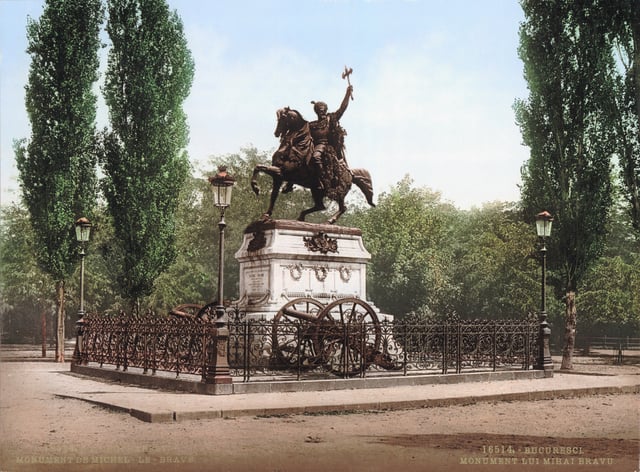
Monument dedicated to Wallachian Prince Michael the Brave (photograph taken between 1890 and 1905).
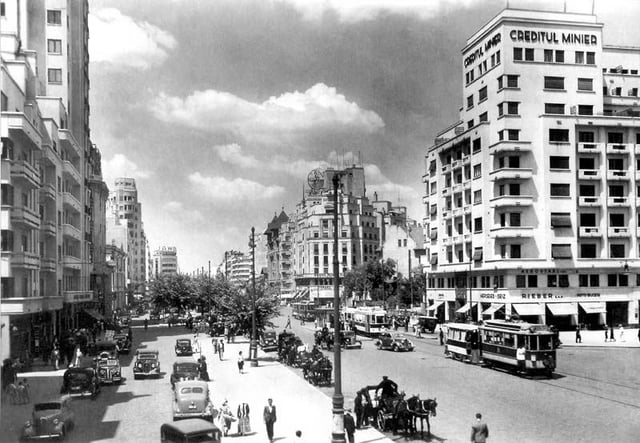
I.C. Brătianu Boulevard during the 1930s.
Bucharest's history alternated periods of development and decline from the early settlements in antiquity until its consolidation as the national capital of Romania late in the 19th century. First mentioned as the "Citadel of București" in 1459, it became the residence of the famous Wallachian prince Vlad III the Impaler.[19] []
The Ottomans appointed Greek administrators (Phanariotes) to run the town from the 18th century. A short-lived revolt initiated by Tudor Vladimirescu in 1821 led to the end of the rule of Constantinople Greeks in Bucharest.[20]
The Old Princely Court (Curtea Veche) was erected by Mircea Ciobanul in the mid-16th century. Under subsequent rulers, Bucharest was established as the summer residence of the royal court. During the years to come, it competed with Târgoviște on the status of capital city after an increase in the importance of southern Muntenia brought about by the demands of the suzerain power – the Ottoman Empire.
Bucharest finally became the permanent location of the Wallachian court after 1698 (starting with the reign of Constantin Brâncoveanu).
Partly destroyed by natural disasters and rebuilt several times during the following 200 years, and hit by Caragea's plague in 1813–14, the city was wrested from Ottoman control and occupied at several intervals by the Habsburg Monarchy (1716, 1737, 1789) and Imperial Russia (three times between 1768 and 1806). It was placed under Russian administration between 1828 and the Crimean War, with an interlude during the Bucharest-centred 1848 Wallachian revolution. Later, an Austrian garrison took possession after the Russian departure (remaining in the city until March 1857). On 23 March 1847, a fire consumed about 2,000 buildings, destroying a third of the city.
In 1862, after Wallachia and Moldavia were united to form the Principality of Romania, Bucharest became the new nation's capital city. In 1881, it became the political centre of the newly proclaimed Kingdom of Romania under King Carol I. During the second half of the 19th century, the city's population increased dramatically, and a new period of urban development began. During this period, gas lighting, horse-drawn trams, and limited electrification were introduced.[21] The Dâmbovița River was also massively channelled in 1883, thus putting a stop to previously endemic floods like the 1865 flooding of Bucharest.[22] The Fortifications of Bucharest were built. The extravagant architecture and cosmopolitan high culture of this period won Bucharest the nickname of "Little Paris" (Micul Paris) of the east, with Calea Victoriei as its Champs-Élysées.
Between 6 December 1916 and November 1918, the city was occupied by German forces as a result of the Battle of Bucharest, with the official capital temporarily moved to Iași (also called Jassy), in the Moldavia region. After World War I, Bucharest became the capital of Greater Romania. In the interwar years, Bucharest's urban development continued, with the city gaining an average of 30,000 new residents each year. Also, some of the city's main landmarks were built in this period, including Arcul de Triumf and Palatul Telefoanelor.[23] However, the Great Depression took its toll on Bucharest's citizens, culminating in the Grivița Strike of 1933.[24]
In January 1941, the city was the scene of the Legionnaires' rebellion and Bucharest pogrom. As the capital of an Axis country and a major transit point for Axis troops en route to the Eastern Front, Bucharest suffered heavy damage during World War II due to Allied bombings. On 23 August 1944, Bucharest was the site of the royal coup which brought Romania into the Allied camp. The city suffered a short period of Nazi Luftwaffe bombings, as well as a failed attempt by German troops to regain the city.
After the establishment of communism in Romania, the city continued growing. New districts were constructed, most of them dominated by tower blocks. During Nicolae Ceaușescu's leadership (1965–89), much of the historic part of the city was demolished and replaced by "Socialist realism" style development: (1) the Centrul Civic (the Civic Centre) and (2) the Palace of the Parliament, for which an entire historic quarter was razed to make way for Ceaușescu's megalomaniac plans. On 4 March 1977, an earthquake centered in Vrancea, about 135 km (83.89 mi) away, claimed 1,500 lives and caused further damage to the historic centre.
The Romanian Revolution of 1989 began with massive anti-Ceaușescu protests in Timișoara in December 1989 and continued in Bucharest, leading to the overthrow of the Communist regime. Dissatisfied with the postrevolutionary leadership of the National Salvation Front, some student leagues and opposition groups organized anti-Communist rallies in early 1990, which caused the political change.
Since 2000, the city has been continuously modernized. Residential and commercial developments are underway, particularly in the northern districts; Bucharest's old historic centre is being restored.
In 2015, Bucharest experienced drama, 64 people were killed in the Colectiv nightclub fire. Later the Romanian capital saw the 2017–2019 Romanian protests against the judicial reforms.[25] On 10 August 2018 a protest under the motto "Diaspora at Home" was held in Bucharest and was marked by significant violence, with over 450 persons injured.[26]
Treaties signed in Bucharest
Treaty of Bucharest, between the Ottoman Empire and the Russian Empire ending the Russo-Turkish War (1806–1812)
Treaty of Bucharest, between Serbia and Bulgaria ending the Serbo-Bulgarian War
Treaty of Bucharest, between Bulgaria, Romania, Serbia, Montenegro, and Greece ending of the Second Balkan War
Treaty of Bucharest, a treaty of alliance between Romania and the Entente Powers
Treaty of Bucharest, between Romania and the Central Powers
Geography
General

Map of the six constituent sectors of Bucharest
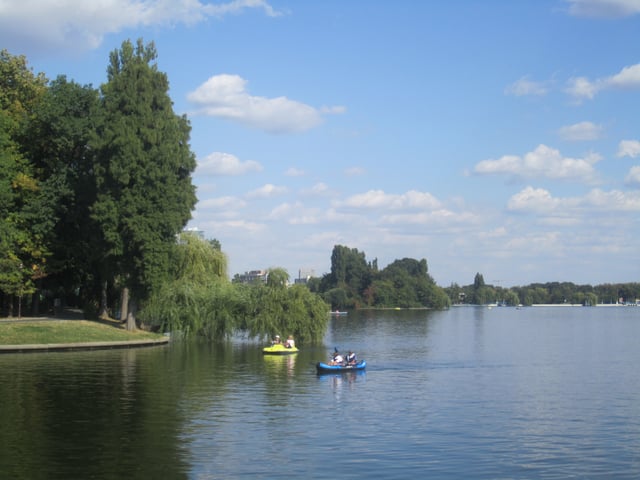
Herăstrău Park is the largest park in Bucharest.
The city is situated on the banks of the Dâmbovița River, which flows into the Argeș River, a tributary of the Danube. Several lakes – the most important of which are Lake Herăstrău, Lake Floreasca, Lake Tei, and Lake Colentina – stretch across the northern parts of the city, along the Colentina River, a tributary of the Dâmbovița. In addition, in the centre of the capital is a small artificial lake – Lake Cișmigiu – surrounded by the Cișmigiu Gardens. These gardens have a rich history, having been frequented by poets and writers. Opened in 1847 and based on the plans of German architect Carl F.W. Meyer, the gardens are the main recreational facility in the city centre.
Bucharest parks and gardens also include Herăstrău Park, Tineretului Park and the Botanical Garden. Herăstrău Park is located in the northern part of the city, around Lake Herăstrău, and includes the site the Village Museum. Grigore Antipa Museum is also near in the Victoriei Square. One of its best known locations are Hard Rock Cafe Bucharest and Berăria H (one of the largest beer halls in Europe). Tineretului Park was created in 1965 and designed as the main recreational space for southern Bucharest. It contains a Mini Town which is a play area for kids. The Botanical Garden, located in the Cotroceni neighborhood a bit west of the city centre, is the largest of its kind in Romania and contains over 10,000 species of plants (many of them exotic); it originated as the pleasure park of the royal family.[27] Besides them, there are many other smaller parks that should be visited, some of them being still large. Alexandru Ioan Cuza Park, Kiseleff Park, Carol Park, Izvor Park, Grădina Icoanei, Circului Park and Moghioroş Park are a few of them. Other large parks in Bucharest are: National Park, Tei Park, Eroilor Park and Crângași Park with Morii Lake.
Lake Văcărești is located in the southern part of the city. Over 190 hectares, including 90 hectares of water, host 97 species of birds, half of them protected by law, and at least seven species of mammals.[28] The lake is surrounded by buildings of flats and is an odd result of human intervention and nature taking its course. The area was a small village that Ceaușescu attempted to convert into a lake. After demolishing the houses and building the concrete basin, the plan was abandoned following the 1989 revolution.[29] For nearly two decades, the area shifted from being an abandoned green space where children could play and sunbathe, to being contested by previous owners of the land there, to being closed for redevelopment into a sports centre. The redevelopment deal failed,[30] and over the following years, the green space grew into a unique habitat. In May 2016, the lake was declared a national park, the Văcărești Nature Park.[31] Dubbed the "Delta of Bucharest, the area is protected.[32]
Bucharest is situated in the southeastern corner of the Romanian Plain, in an area once covered by the Vlăsiei Forest, which after it was cleared, gave way for a fertile flatland. As with many cities, Bucharest is traditionally considered to be built upon seven hills, similar to the seven hills of Rome. Bucharest's seven hills are: Mihai Vodă, Dealul Mitropoliei, Radu Vodă, Cotroceni, Dealul Spirii, Văcărești, and Sfântu Gheorghe Nou.
The city has an area of 226 km2 (87 sq mi). The altitude varies from 55.8 m (183.1 ft) at the Dâmbovița bridge in Cățelu, southeastern Bucharest and 91.5 m (300.2 ft) at the Militari church. The city has a roughly round shape, with the centre situated in the cross-way of the main north-south/east-west axes at University Square. The milestone for Romania's Kilometre Zero is placed just south of University Square in front of the New St. George Church (Sfântul Gheorghe Nou) at St. George Square (Piața Sfântul Gheorghe). Bucharest's radius, from University Square to the city limits in all directions, varies from 10 to 12 km (6 to 7 mi).
Until recently, the regions surrounding Bucharest were largely rural, but after 1989, suburbs started to be built around Bucharest, in the surrounding Ilfov County. Further urban consolidation is expected to take place in the late 2010s, when the "Bucharest Metropolitan Area" plan will become operational, incorporating additional communes and cities from the Ilfov and other neighbouring counties.[33]
Climate
Bucharest has a humid continental climate (Dfa), with warm to hot, humid summers and cold, snowy winters. Owing to its position on the Romanian Plain, the city's winters can get windy, though some of the winds are mitigated due to urbanisation. Winter temperatures often dip below 0 °C (32 °F), sometimes even to −20 °C (−4 °F). In summer, the average temperature is 23 °C (73 °F) (the average for July and August). Temperatures frequently reach 35 to 40 °C (95 to 104 °F) in midsummer in the city centre. Although average precipitation and humidity during summer are low, occasional heavy storms occur. During spring and autumn, daytime temperatures vary between 17 and 22 °C (63 and 72 °F), and precipitation during spring tends to be higher than in summer, with more frequent yet milder periods of rain.
| Climate data for Bucharest Băneasa (1981–2010, extremes 1929–present) | |||||||||||||
|---|---|---|---|---|---|---|---|---|---|---|---|---|---|
| Month | Jan | Feb | Mar | Apr | May | Jun | Jul | Aug | Sep | Oct | Nov | Dec | Year |
| Record high °C (°F) | 17.1 (62.8) | 24.1 (75.4) | 29.0 (84.2) | 32.2 (90.0) | 36.9 (98.4) | 39.0 (102.2) | 42.2 (108.0) | 41.0 (105.8) | 38.5 (101.3) | 35.2 (95.4) | 25.1 (77.2) | 18.4 (65.1) | 42.2 (108.0) |
| Average high °C (°F) | 2.8 (37.0) | 5.5 (41.9) | 11.4 (52.5) | 18.0 (64.4) | 24.0 (75.2) | 27.7 (81.9) | 29.8 (85.6) | 29.8 (85.6) | 24.6 (76.3) | 17.9 (64.2) | 9.8 (49.6) | 3.8 (38.8) | 17.1 (62.8) |
| Daily mean °C (°F) | −1.3 (29.7) | 0.4 (32.7) | 5.4 (41.7) | 11.2 (52.2) | 16.8 (62.2) | 20.6 (69.1) | 22.5 (72.5) | 22.0 (71.6) | 16.9 (62.4) | 11.0 (51.8) | 4.7 (40.5) | 0.2 (32.4) | 10.8 (51.4) |
| Average low °C (°F) | −4.8 (23.4) | −4.0 (24.8) | 0.1 (32.2) | 4.9 (40.8) | 9.6 (49.3) | 13.6 (56.5) | 15.4 (59.7) | 14.9 (58.8) | 10.5 (50.9) | 5.4 (41.7) | 0.6 (33.1) | −3.4 (25.9) | 5.2 (41.4) |
| Record low °C (°F) | −32.2 (−26.0) | −29.0 (−20.2) | −21.7 (−7.1) | −9.5 (14.9) | −1.1 (30.0) | 4.5 (40.1) | 7.4 (45.3) | 5.2 (41.4) | −3.1 (26.4) | −8.0 (17.6) | −19.4 (−2.9) | −25.6 (−14.1) | −32.2 (−26.0) |
| Average precipitation mm (inches) | 37 (1.5) | 37 (1.5) | 44 (1.7) | 50 (2.0) | 56 (2.2) | 83 (3.3) | 70 (2.8) | 56 (2.2) | 64 (2.5) | 53 (2.1) | 46 (1.8) | 48 (1.9) | 643 (25.3) |
| Average snowfall cm (inches) | 13.7 (5.4) | 11.0 (4.3) | 10.5 (4.1) | 1.5 (0.6) | 0.0 (0.0) | 0.0 (0.0) | 0.0 (0.0) | 0.0 (0.0) | 0.0 (0.0) | 0.0 (0.0) | 8.8 (3.5) | 10.5 (4.1) | 56.0 (22.0) |
| Average rainy days | 6 | 6 | 9 | 11 | 12 | 11 | 9 | 8 | 8 | 10 | 10 | 9 | 109 |
| Average snowy days | 8 | 7 | 5 | 1 | 0.03 | 0 | 0 | 0 | 0 | 0.3 | 3 | 7 | 31 |
| Average relative humidity (%) | 89 | 83 | 75 | 71 | 69 | 70 | 68 | 68 | 73 | 79 | 85 | 88 | 76 |
| Mean monthly sunshine hours | 70.6 | 84.5 | 138.0 | 184.8 | 246.3 | 265.8 | 289.2 | 281.4 | 224.1 | 177.4 | 87.5 | 62.8 | 2,112.4 |
| Average ultraviolet index | 1 | 2 | 3 | 5 | 7 | 8 | 8 | 7 | 5 | 3 | 2 | 1 | 4 |
| Source #1: Pogoda.ru.net (average temperatures, humidity, precipitation, and snowy days)[34] | |||||||||||||
| Source #2: NOAA (snowfall and sunshine, 1961–1990),[35] Administrația Națională de Meteorologie (extremes)[36] and Weather Atlas[37] | |||||||||||||
Law and government
Administration

Bucharest City Hall (PMB)
Bucharest has a unique status in Romanian administration, since it is the only municipal area that is not part of a county. Its population, however, is larger than that of any other Romanian county, hence the power of the Bucharest General Municipality (Primăria Generală), which is the capital's local government body, is the same as any other Romanian county council.
The Municipality of Bucharest, along with the surrounding Ilfov County, is part of the București – Ilfov development region project, which is equivalent to NUTS-II regions in the European Union and is used both by the EU and the Romanian government for statistical analysis, and to co-ordinate regional development projects and manage funds from the EU. The Bucharest-Ilfov development region is not, however, an administrative entity yet.
The city government is headed by a general mayor (Primar General). Decisions are approved and discussed by the capital's General Council (Consiliu General) made up of 55 elected councilors. Furthermore, the city is divided into six administrative sectors (sectoare), each of which has its own 27-seat sectoral council, town hall, and mayor. The powers of the local government over a certain area are, therefore, shared both by the Bucharest municipality and the local sectoral councils with little or no overlapping of authority. The general rule is that the main capital municipality is responsible for citywide utilities such as the water and sewage system, the overall transport system, and the main boulevards, while sectoral town halls manage the contact between individuals and the local government, secondary streets and parks maintenance, schools administration, and cleaning services.
The six sectors are numbered from one to six and are disposed radially so that each one has under its administration a certain area of the city centre. They are numbered clockwise and are further divided into sectoral quarters (cartiere) which are not part of the official administrative division:
Sector 1 (population 227,717): Dorobanți, Băneasa, Aviației, Pipera, Aviatorilor, Primăverii, Romană, Victoriei, Herăstrău Park, Bucureștii Noi, Dămăroaia, Strǎulești, Grivița, 1 Mai, Băneasa Forest, Pajura, Domenii, Chibrit
Sector 2 (population 357,338): Pantelimon, Colentina, Iancului, Tei, Floreasca, Moșilor, Obor, Vatra Luminoasă, Fundeni, Plumbuita, Ștefan cel Mare, Baicului
Sector 3 (population 399,231): Vitan, Dudești, Titan, Centrul Civic, Dristor, Lipscani, Muncii, Unirii
Sector 4 (population 300,331): Berceni, Olteniței, Giurgiului, Progresul, Văcărești, Timpuri Noi, Tineretului
Sector 5 (population 288,690): Rahova, Ferentari, Giurgiului, Cotroceni, 13 Septembrie, Dealul Spirii
Sector 6 (population 371,060): Giulești, Crângași, Drumul Taberei, Militari, Grozăvești (also known as Regie), Ghencea
Each sector is governed by a local mayor, as follows: Sector 1 – Daniel Tudorache (PSD, since 2016), Sector 2 – Mihai Mugur Toader (PSD, since 2016), Sector 3 – Robert Negoiță (PSD, since 2012), Sector 4 – Daniel Băluță (PSD, since 2016), Sector 5 – Daniel Florea (PSD, since 2016),[38] Sector 6 – Gabriel Mutu (PSD, since 2016).
Like all other local councils in Romania, the Bucharest sectoral councils, the capital's general council, and the mayors are elected every four years by the population. Additionally, Bucharest has a prefect, who is appointed by Romania's national government. The prefect is not allowed to be a member of a political party and his role is to represent the national government at the municipal level. The prefect is acting as a liaison official facilitating the implementation of national development plans and governing programs at local level. The prefect of Bucharest (as of 2014) is Paul Nicolae Petrovan.[39]
City general council
The city's general council has the following current political composition, based on the results of the latest local elections:
| Party | Seats | Current Council | ||||||||||||||||||||||||
|---|---|---|---|---|---|---|---|---|---|---|---|---|---|---|---|---|---|---|---|---|---|---|---|---|---|---|
| Social Democratic Party (PSD) | 24 | |||||||||||||||||||||||||
| Save Romania Union (USR) | 15 | |||||||||||||||||||||||||
| National Liberal Party (PNL) | 8 | |||||||||||||||||||||||||
| People's Movement Party (PMP) | 4 | |||||||||||||||||||||||||
| Alliance of Liberals and Democrats (ALDE) | 4 | |||||||||||||||||||||||||
Justice system
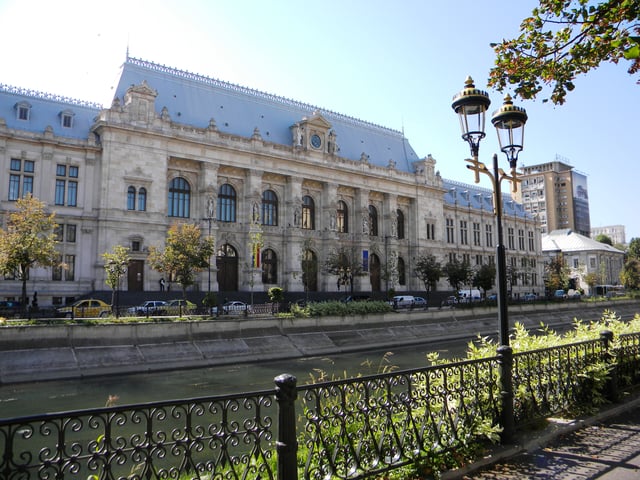
Palace of Justice viewed across the Dâmbovița River
Bucharest's judicial system is similar to that of the Romanian counties. Each of the six sectors has its own local first-instance court (judecătorie), while more serious cases are directed to the Bucharest Tribunal (Tribunalul Bucureşti), the city's municipal court. The Bucharest Court of Appeal (Curtea de Apel Bucureşti) judges appeals against decisions taken by first-instance courts and tribunals in Bucharest and in five surrounding counties (Teleorman, Ialomița, Giurgiu, Călărași, and Ilfov). Bucharest is also home to Romania's supreme court, the High Court of Cassation and Justice, as well as to the Constitutional Court of Romania.
Bucharest has a municipal police force, the Bucharest Police (Poliția București), which is responsible for policing crime within the whole city, and operates a number of divisions. The Bucharest Police are headquartered on Ștefan cel Mare Blvd. in the city centre, and at precincts throughout the city. From 2004 onwards, each sector city hall also has under its administration a community police force (Poliția Comunitară), dealing with local community issues. Bucharest also houses the general inspectorates of the Gendarmerie and the national police.
Crime
Bucharest's crime rate is rather low in comparison to other European capital cities, with the number of total offenses declining by 51% between 2000 and 2004,[40] and by 7% between 2012 and 2013.[41] The violent crime rate in Bucharest remains very low, with 11 murders and 983 other violent offenses taking place in 2007.[42] Although violent crimes fell by 13% in 2013 compared to 2012, 19 murders (18 of which the suspects were arrested) were recorded.[41]
Although in the 2000s, a number of police crackdowns on organized crime gangs occurred, such as the Cămătaru clan, organized crime generally has little impact on public life. Petty crime, however, is more common, particularly in the form of pickpocketing, which occurs mainly on the city's public transport network. Confidence tricks were common in the 1990s, especially in regards to tourists, but the frequency of these incidents has since declined. However, in general, theft was reduced by 13.6% in 2013 compared to 2012.[41] Levels of crime are higher in the southern districts of the city, particularly in Ferentari, a socially disadvantaged area.
Although the presence of street children was a problem in Bucharest in the 1990s, their numbers have declined in recent years, now lying at or below the average of major European capital cities.[43]
Quality of life
As stated by the Mercer international surveys for quality of life in cities around the world, Bucharest occupied the 94th place in 2001[44] and slipped lower, to the 108th place in 2009 and the 107th place in 2010. Compared to it, Vienna occupied number one worldwide in 2011 and 2009.[45] Warsaw ranked 84th, Istanbul 112th, and neighbours Sofia 114th and Belgrade 136th (in the 2010 rankings).[46]
Mercer Human Resource Consulting issues yearly a global ranking of the world's most livable cities based on 39 key quality-of-life issues. Among them: political stability, currency-exchange regulations, political and media censorship, school quality, housing, the environment, and public safety. Mercer collects data worldwide, in 215 cities. The difficult situation of the quality of life in Bucharest is confirmed also by a vast urbanism study, done by the Ion Mincu University of Architecture and Urbanism.[47]
In 2016, Bucharest's urban situation was described as 'critical' by a Romanian Order of Architects (OAR) report that criticised the city's weak, incoherent and arbitrary public management policies, its elected officials' lack of transparency and public engagement, as well as its inadequate and unsustainable use of essential urban resources.[48] Bucharest's historical city centre is listed as "endangered" by the World Monuments Watch (as of 2016).[12]
Although many neighbourhoods, particularly in the southern part of the city, lack sufficient green space, being formed of cramped high density block of flats, Bucharest also has many parks.[49]
Demographics
| Historical population | ||
|---|---|---|
| Year | Pop. | ±% |
| 1595 | 10,000 | — |
| 1650 | 20,000 | +100.0% |
| 1789 | 30,030 | +50.2% |
| 1831 | 60,587 | +101.8% |
| 1851 | 60,000 | −1.0% |
| 1859 | 121,734 | +102.9% |
| 1877 | 177,646 | +45.9% |
| 1900 | 282,071 | +58.8% |
| 1912 | 341,321 | +21.0% |
| 1930 | 639,040 | +87.2% |
| 1948 | 1,025,180 | +60.4% |
| 1956 | 1,177,661 | +14.9% |
| 1966 | 1,366,684 | +16.1% |
| 1977 | 1,807,239 | +32.2% |
| 1992 | 2,064,474 | +14.2% |
| 2002 | 1,926,334 | −6.7% |
| 2011 | 1,883,425 | −2.2% |
| 2016 (est.) | 2,106,144 | +11.8% |
| 1851 data: Chambers's Encyclopaedia,[50] 1900: Encyclopædia Britannica,[51] Other data:[52][53][54] | ||
As per the 2011 census, 1,883,425 inhabitants lived within the city limits, a decrease from the figure recorded at the 2002 census.[6] This decrease is due to low natural increase, but also to a shift in population from the city itself to its smaller satellite towns such as Voluntari, Buftea, and Otopeni. In a study published by the United Nations, Bucharest placed 19th in among 28 cities that recorded sharp declines in population from 1990 to the mid-2010s. In particular, the population fell by 3.77%.[55]
Bucharest's population experienced two phases of rapid growth, the first beginning in the late 19th century when the city was consolidated as the national capital and lasting until the Second World War, and the second during the Ceaușescu years (1965–1989), when a massive urbanization campaign was launched and many people migrated from rural areas to the capital. At this time, due to Ceaușescu's decision to ban abortion and contraception, natural increase was also significant.
Bucharest is a city of high population density: 8,260/km2 (21,400/sq mi),[57] owing to the fact that most of the population lives in high-density communist era apartment blocks (blocuri). However, this also depends on the part of the city: the southern boroughs have a higher density than the northern ones. Of the European Union country capital-cities, only Paris and Athens have a higher population density (see List of European Union cities proper by population density).
About 96.6% of the population of Bucharest is Romanian.[58] Other significant ethnic groups are Roma Gypsies, Hungarians, Germans, Jews, Turks, and Chinese. A relatively small number of Bucharesters are also of Greek, North American, French, Arab, Armenian, African, Tatar, Vietnamese, Lippovan, and Italian descent. One of the predominantly Greek neighborhoods was Vitan – where a Jewish population also lived (with a population of 69,885 (10.9%) out of the total of 639,040, as of 1930 census,[59] Jews were the second-largest ethnic group in Bucharest); they were more present in Văcărești and areas around Unirii Square.
In terms of religious affiliation, 96.1% of the population is Romanian Orthodox, 1.2% is Roman Catholic, 0.5% is Muslim, and 0.4% is Romanian Greek Catholic. Despite this, only 18% of the population, of any religion, attends a place of worship once a week or more.[60] The life expectancy of residents of Bucharest in 2003–2005 was 74.14 years, around two years higher than the Romanian average. Female life expectancy was 77.41 years, in comparison to 70.57 years for males.[61]
Economy
Bucharest is the center of the Romanian economy and industry, accounting for around 24% (2017) of the country's GDP and about one-quarter of its industrial production, while being inhabited by 9% of the country's population.[62] Almost one-third of national taxes is paid by Bucharest's citizens and companies..The living standard in the Bucharest-Ilfov region was 145% of the EU average in 2017, according to GDP per capita at the purchasing power parity standard (adjusted to the national price level).
Bucharest area surpassed, on comparable terms, European metropolitan areas such as Budapest (139%), Madrid (125%), Berlin (118%), Rome (110%), Lisbon (102%) or Sofia (79%). and more than twice the Romanian average.[63] After relative stagnation in the 1990s, the city's strong economic growth has revitalized infrastructure and led to the development of shopping malls, residential estates, and high-rise office buildings. In January 2013, Bucharest had an unemployment rate of 2.1%, significantly lower than the national unemployment rate of 5.8%.[64][65]
Bucharest's economy is centered on industry and services, with services particularly growing in importance in the last 10 years. The headquarters of 186,000 firms, including nearly all large Romanian companies, are located in Bucharest.[66] An important source of growth since 2000 has been the city's rapidly expanding property and construction sector. Bucharest is also Romania's largest centre for information technology and communications and is home to several software companies operating offshore delivery centres. Romania's largest stock exchange, the Bucharest Stock Exchange, which was merged in December 2005 with the Bucharest-based electronic stock exchange Rasdaq, plays a major role in the city's economy.
International supermarket chains such as Kaufland, Lidl, Metro, Selgros, Penny Market, Carrefour, Auchan, Cora, Profi and Mega Image are all operating in Bucharest. The city is undergoing a retail boom. Bucharest hosts luxury brands such as Armani, Versace, Ralph Lauren, Dior, Prada, Chanel, Hermes, Louis Vuitton and Gucci. Malls and large shopping centres have been built since the late 1990s, such as Băneasa Shopping City, AFI Palace Cotroceni, Mega Mall, București Mall, ParkLake Shopping Center, Sun Plaza, Promenada Mall and longest Unirea Shopping Center. Bucharest has over 20 malls as of 2019.[67][68]
IT corporations Amazon, Microsoft, Oracle Corporation or IBM are all present in the Romanian capital. The top ten is also dominated by companies operating in automotive, oil & gas (such as Petrom), as well as companies in telecommunication and FMCG.[69][70]
Transport
Bucharest in crossed by two major international routes: Pan-European transport corridor IV and IX.
Public transport

A tram on Nicolae Titulescu avenue

Victorie Square station, Bucharest Metro
Bucharest's public transport system is the largest in Romania and one of the largest in Europe. It is made up of the Bucharest Metro, run by Metrorex, as well as a surface transport system run by STB (Societatea de Transport București, previously known as the RATB), which consists of buses, trams, trolleybuses, and light rail. In addition, a private minibus system operates there. As of 2007, a limit of 10,000 taxicab licenses was imposed.[71]
Railways
It is the hub of Romania's national railway network, run by Căile Ferate Române. The main railway station is Gara de Nord ("North Station"), which provides connections to all major cities in Romania, as well as international destinations: Belgrade, Sofia, Varna, Chișinău, Kiev, Chernivtsi, Lviv, Thessaloniki, Vienna, Budapest, Istanbul, Moscow etc.
The city has five other railway stations run by CFR, of which the most important are Basarab (adjacent to North Station), Obor, Băneasa, and Progresul. These are in the process of being integrated into a commuter railway serving Bucharest and the surrounding Ilfov County. Seven main lines radiate out of Bucharest.
The oldest station in Bucharest is Filaret. It was inaugurated in 1869, and in 1960, the communist government turned it in a bus terminal.[72]
Air

Henri Coandă International Airport
Bucharest has two international airports:
Henri Coandă International Airport (IATA: OTP, ICAO: LROP), located 16.5 km (10.3 mi) north of the Bucharest city center, in the town of Otopeni, Ilfov. It is the busiest airport in Romania, in terms of passenger traffic: 12,807,032 in 2017.[73]
Aurel Vlaicu International Airport (IATA: BBU, ICAO: LRBS) is Bucharest's business and VIP airport. It is situated only 8 km (5.0 mi) north of the Bucharest city center, within city limits.
Roads
Bucharest is a major intersection of Romania's national road network. A few of the busiest national roads and motorways link the city to all of Romania's major cities, as well as to neighbouring countries such as Hungary, Bulgaria and Ukraine. The A1 to Pitești, the A2 Sun Motorway to the Dobrogea region and Constanța and the A3 to Ploiești all start from Bucharest.
A series of high-capacity boulevards, which generally radiate out from the city centre to the outskirts, provides a framework for the municipal road system. The main axes, which run north-south, east-west and northwest-southeast, as well as one internal and one external ring road, support the bulk of the traffic.
The city's roads are usually very crowded during rush hours, due to an increase in car ownership in recent years. In 2013, the number of cars registered in Bucharest amounted to 1,125,591.[74] This results in wear and potholes appearing on busy roads, particularly secondary roads, this being identified as one of Bucharest's main infrastructural problems. A comprehensive effort on behalf of the City Hall to boost road infrastructure was made, and according to the general development plan, 2,000 roads have been repaired by 2008.[75] The huge number of cars registered in the city forced the Romanian Auto Registry to switch to 3-digit numbers on registration plates in 2010.
On 17 June 2011, the Basarab Overpass was inaugurated and opened to traffic, thus completing the inner city traffic ring. The overpass took five years to build and is the longest cable-stayed bridge in Romania and the widest such bridge in Europe;[76] upon completion, traffic on the Grant Bridge and in the Gara de Nord area became noticeably more fluid.[77]
Water
Although it is situated on the banks of a river, Bucharest has never functioned as a port city, with other Romanian cities such as Constanța and Galați acting as the country's main ports. The unfinished Danube-Bucharest Canal, which is 73 km (45 mi) long and around 70% completed, could link Bucharest to the Danube River, and via the Danube-Black Sea Canal, to the Black Sea. Works on the canal were suspended in 1989, but proposals have been made to resume construction as part of the European Strategy for the Danube Region.[78]
Culture
Bucharest has a growing cultural scene, in fields including the visual arts, performing arts, and nightlife. Unlike other parts of Romania, such as the Black Sea coast or Transylvania, Bucharest's cultural scene has no defined style, and instead incorporates elements of Romanian and international culture.
Landmarks
Bucharest has landmark buildings and monuments. Perhaps the most prominent of these is the Palace of the Parliament, built in the 1980s during the reign of Communist dictator Nicolae Ceaușescu. The largest Parliament building in the world, the palace houses the Romanian Parliament (the Chamber of Deputies, and the Senate), as well as the National Museum of Contemporary Art. The building boasts one of the largest convention centres in the world.
Another landmark in Bucharest is Arcul de Triumf (The Triumphal Arch), built in its current form in 1935 and modeled after the Arc de Triomphe in Paris. A newer landmark of the city is the Memorial of Rebirth, a stylized marble pillar unveiled in 2005 to commemorate the victims of the Romanian Revolution of 1989, which overthrew Communism. The abstract monument sparked controversy when it was unveiled, being dubbed with names such as "the olive on the toothpick", (măslina-n scobitoare), as many argued that it does not fit in its surroundings and believed that its choice was based on political reasons.[79]
The Romanian Athenaeum building is considered to be a symbol of Romanian culture and since 2007 is on the list of the Label of European Heritage sites.[80]
InterContinental Bucharest is a high-rise five-star hotel situated near University Square and is also a landmark of the city. The building is designed so that each room has a unique panorama of the city.[81]
House of the Spark (Casa Scânteii) is a replica of the famous “Lomonosov” Moscow State University. This edifice built in the characteristic style of the large-scale Soviet projects, was intended to be representative to the new political regime and to assert the superiority of the Communist doctrine. Construction started in 1952 and was completed in 1957, a few years after Stalin's death that occurred in 1953. Popularly known as Casa Scânteii (“House of the Spark”) after the name of the official gazette of the Central Committee of the Romanian Communist Party, Scânteia, it was made for the purpose of bringing together under one roof all of Bucharest's official press and publishing houses. It is the only building in Bucharest featuring the “Hammer and Sickle”, the Red Star and other communist insignia carved into medallions adorning the façade.
Other cultural venues include the National Museum of Art of Romania, Grigore Antipa National Museum of Natural History, Museum of the Romanian Peasant, National History Museum and the Military Museum.
Visual arts

National Museum of Art of Romania
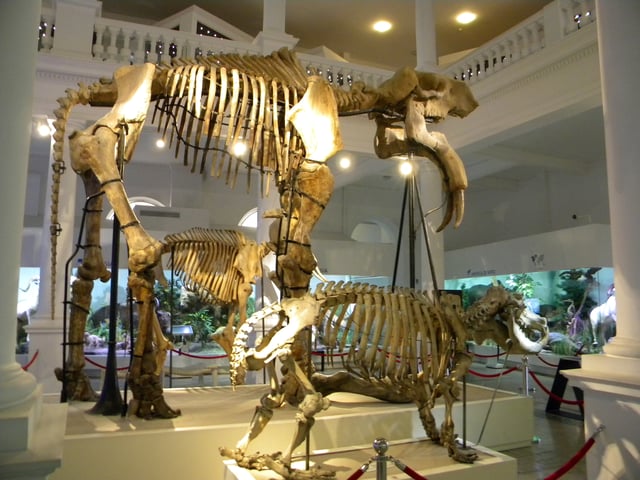
Grigore Antipa National Museum of Natural History reopened in 2011 after $13 million renovation.[83]
In terms of visual arts, the city has museums featuring both classical and contemporary Romanian art, as well as selected international works. The National Museum of Art of Romania is perhaps the best-known of Bucharest museums. It is located in the royal palace and features collections of medieval and modern Romanian art, including works by sculptor Constantin Brâncuși, as well as an international collection assembled by the Romanian royal family.
Other, smaller, museums contain specialised collections. The Zambaccian Museum, which is situated in the former home of art collector Krikor H. Zambaccian, contains works by well-known Romanian artists and international artists such as Paul Cézanne, Eugène Delacroix, Henri Matisse, Camille Pissarro, and Pablo Picasso.
The Gheorghe Tattarescu Museum contains portraits of Romanian revolutionaries in exile such as Gheorghe Magheru, ștefan Golescu, and Nicolae Bălcescu, and allegorical compositions with revolutionary (Romania's rebirth, 1849) and patriotic (The Principalities' Unification, 1857) themes. Another impressive art collection gathering important Romanian painters, can be found at the Ligia and Pompiliu Macovei residence, which is open to visitors as it is now part of the Bucharest Museum patrimony.
The Theodor Pallady Museum is situated in one of the oldest surviving merchant houses in Bucharest and includes works by Romanian painter Theodor Pallady, as well as European and oriental furniture pieces. The Museum of Art Collections contains the collections of Romanian art aficionados, including Krikor Zambaccian and Theodor Pallady.
Despite the classical art galleries and museums in the city, a contemporary arts scene also exists. The National Museum of Contemporary Art (MNAC), situated in a wing of the Palace of the Parliament, was opened in 2004 and contains Romanian and international contemporary art. The MNAC also manages the Kalinderu MediaLab, which caters to multimedia and experimental art. Private art galleries are scattered throughout the city centre.
The palace of the National Bank of Romania houses the national numismatic collection. Exhibits include banknotes, coins, documents, photographs, maps, silver and gold bullion bars, bullion coins, and dies and moulds. The building was constructed between 1884 and 1890. The thesaurus room contains notable marble decorations.
Performing arts

Odeon Theater
Performing arts are some of the strongest cultural elements of Bucharest. The most famous symphony orchestra is National Radio Orchestra of Romania. One of the most prominent buildings is the neoclassical Romanian Athenaeum, which was founded in 1852, and hosts classical music concerts, the George Enescu Festival, and is home to the George Enescu Philharmonic Orchestra.
Bucharest is home to the Romanian National Opera and the I.L. Caragiale National Theatre. Another well-known theatre in Bucharest is the State Jewish Theatre, which features plays starring world-renowned Romanian-Jewish actress Maia Morgenstern. Smaller theatres throughout the city cater to specific genres, such as the Comedy Theatre, the Nottara Theatre, the Bulandra Theatre, the Odeon Theatre, and the revue theatre of Constantin Tănase.
Music and nightlife
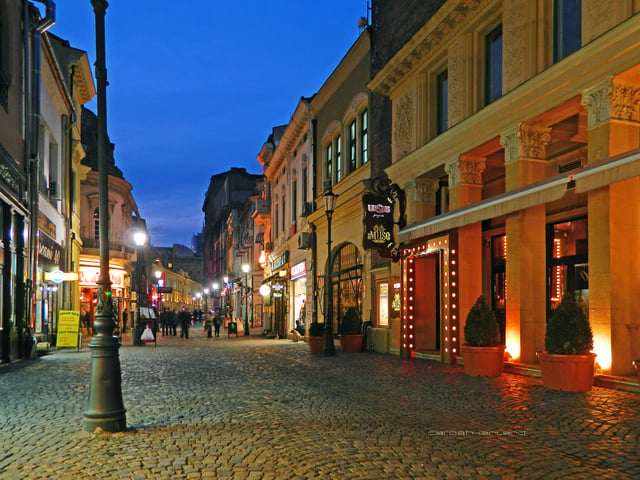
The Old Town is the heart of Bucharest nightlife.
Bucharest is home to Romania's largest recording labels, and is often the residence of Romanian musicians. Romanian rock bands of the 1970s and 1980s, such as Iris and Holograf, continue to be popular, particularly with the middle-aged, while since the beginning of the 1990s, the hip hop/rap scene has developed. Hip-hop bands and artists from Bucharest such as B.U.G. Mafia, Paraziții, and La Familia enjoy national and international recognition.
The pop-rock band Taxi have been gaining international respect, as has Spitalul de Urgență's raucous updating of traditional Romanian music. While many neighbourhood discos play manele, an Oriental- and Roma-influenced genre of music that is particularly popular in Bucharest's working-class districts, the city has a rich jazz and blues scene, and to an even larger extent, house music/trance and heavy metal/punk scenes. Bucharest's jazz profile has especially risen since 2002, with the presence of two venues, Green Hours and Art Jazz, as well as an American presence alongside established Romanians.
With no central nightlife strip, entertainment venues are dispersed throughout the city, with clusters in Lipscani and Regie.
Cultural events and festivals
A number of cultural festivals are held in Bucharest throughout the year, but most festivals take place in June, July, and August. The National Opera organises the International Opera Festival every year in May and June, which includes ensembles and orchestras from all over the world.
The Romanian Athaeneum Society hosts the George Enescu Festival at locations throughout the city in September every two years (odd years). The Museum of the Romanian Peasant and the Village Museum organise events throughout the year, showcasing Romanian folk arts and crafts.
In the 2000s, due to the growing prominence of the Chinese community in Bucharest, Chinese cultural events took place. The first officially organised Chinese festival was the Chinese New Year's Eve Festival of February 2005, which took place in Nichita Stănescu Park and was organised by the Bucharest City Hall.[84]
In 2005, Bucharest was the first city in Southeastern Europe to host the international CowParade, which resulted in dozens of decorated cow sculptures being placed across the city.
In 2004, Bucharest imposed in the circle of important festivals in Eastern Europe with the Bucharest International Film Festival, an event widely acknowledged in Europe, having as guests of honor famous names from the world cinema: Andrei Konchalovsky, Danis Tanović, Nikita Mikhalkov, Rutger Hauer, Jerzy Skolimowski, Jan Harlan, Radu Mihăileanu, and many others.[85]
Since 2005, Bucharest has its own contemporary art biennale, the Bucharest Biennale.
Traditional culture
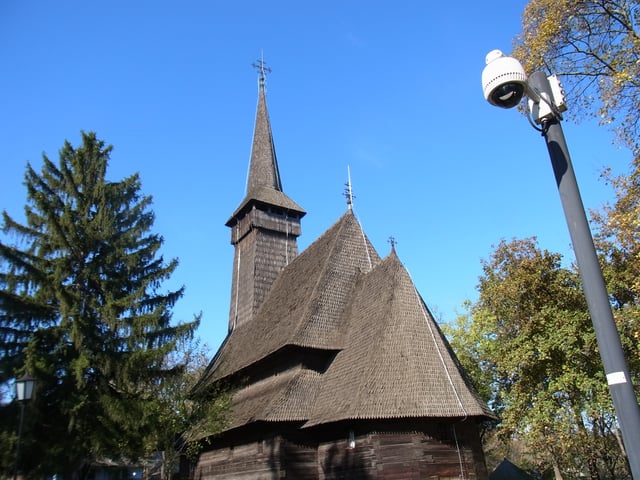
Traditional Romanian wooden church at Village Museum
Traditional Romanian culture continues to have a major influence in arts such as theatre, film, and music. Bucharest has two internationally renowned ethnographic museums, the Museum of the Romanian Peasant and the open-air Dimitrie Gusti National Village Museum, in King Michael I Park. It contains 272 authentic buildings and peasant farms from all over Romania.[86]
The Museum of the Romanian Peasant was declared the European Museum of the Year in 1996. Patronized by the Ministry of Culture, the museum preserves and exhibits numerous collections of objects and monuments of material and spiritual culture. The Museum of the Romanian Peasant holds one of the richest collections of peasant objects in Romania, its heritage being nearly 90,000 pieces, those being divided into several collections: ceramics, costumes, textiles, wooden objects, religious objects, customs, etc.[87]
The Museum of Romanian History is another important museum in Bucharest, containing a collection of artefacts detailing Romanian history and culture from the prehistoric times, Dacian era, medieval times, and the modern era.
Religion
Bucharest is the seat of the Patriarch of the Romanian Orthodox Church, one of the Eastern Orthodox churches in communion with the Patriarch of Constantinople, and also of its subdivisions, the Metropolis of Muntenia and Dobrudja and the Archbishopric of Bucharest. Orthodox believers consider Demetrius Basarabov to be the patron saint of the city.
The city is a center for other Christian organizations in Romania, including the Roman Catholic Archdiocese of Bucharest, established in 1883, and the Romanian Greek-Catholic Eparchy of Saint Basil the Great, founded in 2014.
Bucharest also hosts 6 synagogues, including the Choral Temple of Bucharest, the Great Synagogue of Bucharest and the Holy Union Temple. The latter was converted into the Museum of the History of the Romanian Jewish Community, while the Great Synagogue and the Choral Temple are both active and hold regular services.[88]
Architecture
The city centre is a mixture of medieval, neoclassical, Art Deco and Art Nouveau buildings, as well as 'neo-Romanian' buildings dating from the beginning of the 20th century and a collection of modern buildings from the 1920s and 1930s. The mostly utilitarian Communist-era architecture dominates most southern boroughs. Recently built contemporary structures such as skyscrapers and office buildings complete the landscape.
Historical architecture
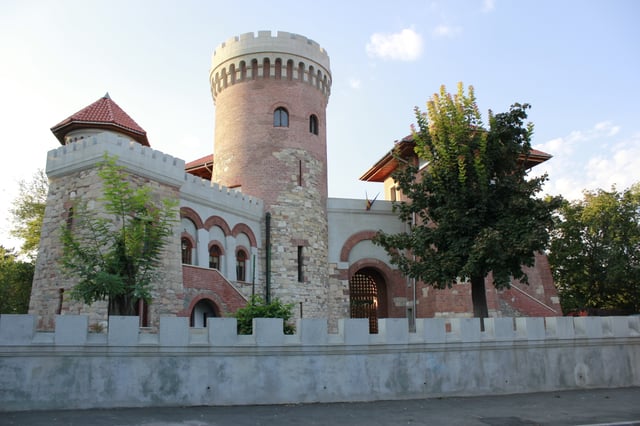
Vlad the Impaler Castle (Vlad Țepeș Castle)
Of the city's medieval architecture, most of what survived into modern times was destroyed by Communist systematization, fire, and military incursions. Some medieval and renaissance edifices remain, the most notable are in the Lipscani area. This precinct contains notable buildings such as Manuc's Inn (Hanul lui Manuc) and the ruins of the Old Court (Curtea Veche); during the late Middle Ages, this area was the heart of commerce in Bucharest. From the 1970s onwards, the area went through urban decline, and many historical buildings fell into disrepair. In 2005, the Lipscani area was restored.[91]
To execute a massive redevelopment project during the rule of Nicolae Ceausescu, the government conducted extensive demolition of churches and many other historic structures in Romania. According to Alexandru Budişteanu, former chief architect of Bucharest, "The sight of a church bothered Ceauşescu. It didn't matter if they demolished or moved it, as long as it was no longer in sight." Nevertheless, a project organised by Romanian engineer Eugeniu Iordǎchescu was able to move many historic structures to less-prominent sites and save them.[92]
The city centre has retained architecture from the late 19th and early 20th centuries, particularly the interwar period, which is often seen as the "golden age" of Bucharest architecture. During this time, the city grew in size and wealth, therefore seeking to emulate other large European capitals such as Paris. Much of the architecture of the time belongs to a Modern (rationalist) Architecture current, led by Horia Creangă and Marcel Iancu.
In Romania, the tendencies of innovation in the architectural language met the need of valorisation and affirmation of the national cultural identity. The Art Nouveau movement finds expression through new architectural style initiated by Ion Mincu and taken over by other prestigious architects who capitalize important references of Romanian laic and medieval ecclesiastical architecture (for example the Mogoșoaia Palace, the Stavropoleos Church or the disappeared church of Văcărești Monastery) and Romanian folk motifs.[93]
Two notable buildings from this time are the Crețulescu Palace, housing cultural institutions including UNESCO's European Centre for Higher Education, and the Cotroceni Palace, the residence of the Romanian President. Many large-scale constructions such as the Gara de Nord, the busiest railway station in the city, National Bank of Romania's headquarters, and the Telephone Palace date from these times. In the 2000s, historic buildings in the city centre underwent restoration. In some residential areas of the city, particularly in high-income central and northern districts, turn-of-the-20th-century villas were mostly restored beginning in the late 1990s.
Communist era architecture
A major part of Bucharest's architecture is made up of buildings constructed during the Communist era replacing the historical architecture with high-density apartment blocks – significant portions of the historic center of Bucharest were demolished to construct one of the largest buildings in the world, the Palace of the Parliament (then officially called the House of the Republic). In Nicolae Ceaușescu's project of systematization, new buildings were built in previously historical areas, which were razed and then built upon.
One of the singular examples of this type of architecture is Centrul Civic, a development that replaced a major part of Bucharest's historic city centre with giant utilitarian buildings, mainly with marble or travertine façades, inspired by North Korean architecture. The mass demolitions that occurred in the 1980s, under which an overall area of eight square kilometres of the historic center of Bucharest were leveled, including monasteries, churches, synagogues, a hospital, and a noted Art Deco sports stadium, changed drastically the appearance of the city. Communist-era architecture can also be found in Bucharest's residential districts, mainly in blocuri, which are high-density apartment blocks that house the majority of the city's population. Initially, these apartment blocks started to be constructed in the 1960s, on relatively empty areas and fields (good examples include Pajura, Drumul Taberei, Berceni and Titan), however with the 1970s, they mostly targeted peripheral neighborhoods such as Colentina, Pantelimon, Militari and Rahova. Construction of these apartment blocks were also often randomized, for instance some small streets were demolished and later widened with the blocks being built next to them, but other neighboring streets were left intact (like in the example of Calea Moșilor from 1978-1982), or built in various patterns such as the Piața Iancului-Lizeanu apartment buildings from 1962-1963.
There is also communist architecture that was built in the early years of the system, in the late 1940s and 1950s. Buildings constructed in this era followed the Soviet Stalinist trend of Socialist Realism, and include the House of the Free Press (which was named Casa Scînteii during communism).
Contemporary architecture
Since the fall of Communism in 1989, several Communist-era buildings have been refurbished, modernized, and used for other purposes.[94] Perhaps the best example of this is the conversion of obsolete retail complexes into shopping malls and commercial centres. These giant, circular halls, which were unofficially called hunger circuses due to the food shortages experienced in the 1980s, were constructed during the Ceaușescu era to act as produce markets and refectories, although most were left unfinished at the time of the revolution.
Modern shopping malls such as the Unirea Shopping Center, Bucharest Mall, Plaza Romania, and City Mall emerged on pre-existent structures of former hunger circuses. Another example is the conversion of a large utilitarian construction in Centrul Civic into a Marriott Hotel. This process was accelerated after 2000, when the city underwent a property boom, and many Communist-era buildings in the city centre became prime real estate due to their location. Many Communist-era apartment blocks have also been refurbished to improve urban appearance.
The newest contribution to Bucharest's architecture took place after the fall of Communism, particularly after 2000, when the city went through a period of urban renewal – and architectural revitalization – on the back of Romania's economic growth. Buildings from this time are mostly made of glass and steel, and often have more than 10 storeys. Examples include shopping malls (particularly the Bucharest Mall, a conversion and extension of an abandoned building), office buildings, bank headquarters, etc.
During the last ten years, several high rise office buildings were built, particularly in the northern and eastern parts of the city. Additionally, a trend to add modern wings and façades to historic buildings has occurred, the most prominent example of which is the Bucharest Architects' Association Building, which is a modern glass-and-steel construction built inside a historic stone façade. In 2013, the Bucharest skyline enriched with a 137-m-high office building (SkyTower of Floreasca City Center), currently the tallest building in Romania. Examples of modern skyscrapers built in the 21st century include Bucharest Tower Center, Euro Tower, Nusco Tower, Cathedral Plaza, City Gate Towers, Rin Grand Hotel, Premium Plaza, Bucharest Corporate Center, Millennium Business Center, PGV Tower, Charles de Gaulle Plaza, Business Development Center Bucharest, BRD Tower, and Bucharest Financial Plaza. Despite this development on vertical, Romanian architects avoid designing very tall buildings due to vulnerability to earthquakes.[95]
Aside from buildings used for business and institutions, residential developments have also been built, many of which consist of high-rise office buildings and suburban residential communities. An example of a new high rise residential complex is Asmita Gardens. These developments are increasingly prominent in northern Bucharest, which is less densely populated and is home to middle- and upper-class Bucharesters due to the process of gentrification.
Education
Overall, 159 faculties are in 34 universities. Sixteen public universities are in Bucharest, the largest of which are the University of Bucharest, the Politehnica University of Bucharest, the Bucharest Academy of Economic Studies, the Carol Davila University of Medicine and Pharmacy, the National University of Political Studies and Public Administration and the University of Agronomic Sciences and Veterinary Medicine of Bucharest.
These are supplemented by nineteen private universities, such as the Romanian-American University and Spiru Haret University, the latter being the largest in Europe with some 302,000 enrolled students in 2009.[96] Private universities, however, have a mixed reputation due to irregularities in the educational process[97] as well as perceived corruption.[98]
Over 450 public primary and secondary schools are in the city, all of which are administered by the Bucharest Municipal Schooling Inspectorate. Each sector also has its own Schooling Inspectorate, subordinated to the municipal one.
Telecommunications and media
The city is well-served by a modern landline and mobile network. Offices of Poșta Română, the national postal operator, are spread throughout the city, with the central post office (Romanian: Oficiul Poștal București 1) located at 12 Matei Millo Street. Public telephones are located in many places and are operated by Telekom Romania, a subsidiary of Deutsche Telekom and successor of the former monopoly Romtelecom.
Bucharest is headquarters of most of the national television networks and national newspapers, radio stations and online news websites. The largest daily newspapers in Bucharest include Evenimentul Zilei, Jurnalul Național, Cotidianul, România Liberă, and Adevărul, while the biggest news websites are Hotnews.ro (with an English and Spanish version), Ziare.com, and Gândul. During the rush hours, tabloid newspapers Click!, Libertatea, and Cancan are popular for commuters.
A number of newspapers and media publications are based in Casa Presei Libere (The House of the Free Press), a landmark of northern Bucharest, originally named Casa Scânteii after the Communist Romania-era official newspaper Scînteia. Casa Presei Libere is not the only Bucharest landmark that grew out of the media and communications industry. Palatul Telefoanelor ("The Telephone Palace") was the first major modernist building on Calea Victoriei in the city's centre, and the massive, unfinished communist-era Casa Radio looms over a park a block away from the Opera.
English-language newspapers first became available in the early 1930s and reappeared in the 1990s. The two daily English-language newspapers are the Bucharest Daily News and Nine O' Clock; several magazines and publications in other languages are available, such as the Hungarian-language daily Új Magyar Szó.
Observator Cultural covers the city's arts, and the free weekly magazines Șapte Seri ("Seven Evenings") and B24FUN, list entertainment events. The city is home to the intellectual journal Dilema veche and the satire magazine Academia Cațavencu.
Healthcare
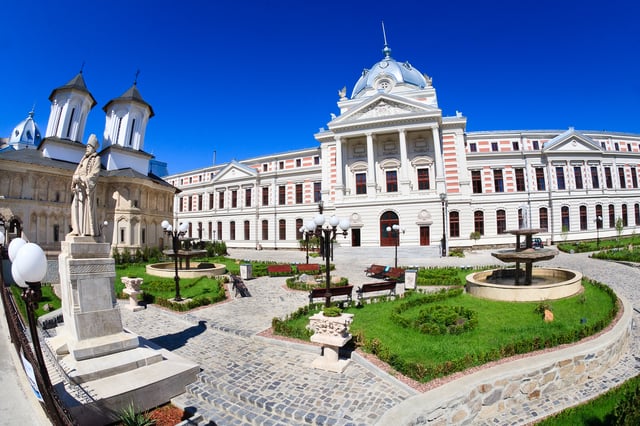
Colțea Hospital
One of the most modern hospitals in the capital is Colțea that has been re-equipped after a 90-million-euro investment in 2011. It specializes in oncological and cardiac disorders. It was built by Mihai Cantacuzino between 1701 and 1703, composed of many buildings, each with 12 to 30 beds, a church, three chapels, a school, and doctors' and teachers' houses.[103]
Another conventional hospital is Pantelimon, which was established in 1733 by Grigore II Ghica. The surface area of the hospital land property was 400,000 m2 (4,305,564 sq ft). The hospital had in its inventory a house for infectious diseases and a house for persons with disabilities.
Other hospitals or clinics are Bucharest Emergency Hospital, Floreasca Emergency Clinic Hospital, Bucharest University Emergency Hospital, and Fundeni Clinical Institute or Biomedica International and Euroclinic, which are private.
Sports

Arena Națională will host UEFA Euro 2020 matches.

Romexpo Dome
Football is the most widely followed sport in Bucharest, with the city having numerous club teams, some of them being known throughout Europe: Steaua București, Dinamo București or Rapid București.
Sport clubs have formed for handball, water polo, volleyball, rugby union, basketball and ice hockey. The majority of Romanian track and field athletes and most gymnasts are affiliated with clubs in Bucharest. The largest indoor arena in Bucharest is the Romexpo Dome with a seating capacity of 40,000. It can be used for boxing, kickboxing, handball and tennis.
Starting in 2007, Bucharest has hosted annual races along a temporary urban track surrounding the Palace of the Parliament, called Bucharest Ring. The competition is called the Bucharest City Challenge, and has hosted FIA GT, FIA GT3, British F3, and Logan Cup races in 2007 and 2008. The 2009 and 2010 edition have not been held in Bucharest due to a lawsuit. Bucharest GP won the lawsuit that it initiated and will host city races around the Parliament starting 2011 with the Auto GP.[106] Since 2009, Bucharest has the largest Ferrari Shop in Eastern Europe and the 2nd largest in Europe after Milan shop.[107][108]
Every year, Bucharest hosts the Bucharest Open international tennis tournament, which is included in the WTA Tour. The outdoor tournament is hosted by the tennis complex BNR Arenas. Ice hockey games are held at the Mihai Flamaropol Arena, which holds 8,000 spectators. Rugby games are held in different locations, but the most modern stadium is Arcul de Triumf Stadium, which is also home to the Romanian national rugby team.
Natives
Nicolae Crețulescu (1812–1900), medical doctor and politician, second Prime Minister of Romania following the assassination of Barbu Catargiu; one of the first presidents of the Romanian Academy
Constantin Bosianu (1815–1882), law professor and head of the Senate, Prime Minister of Romania and first dean of the Faculty of Law in Bucharest
C. A. Rosetti (1816–1885), writer, politician and leader of the Wallachian Revolution of 1848; the Romanian Academy was founded on his initiative
Ion Ghica (1816–1897), economist, engineer, mathematician, writer, revolutionary, diplomat and Prime Minister of Romania
Dimitrie Ghica (1816–1897), army officer, police prefect, politician, mayor of Bucharest and Prime Minister of Romania
Nicolae Bălcescu (1819–1852), historian, writer, soldier and leader of the Wallachian Revolution of 1848
Ioan Kalinderu (1840–1814), law professor, writer, silviculturist, confidant of King Carol I and head of the Romanian Academy
Ion I. Câmpineanu (1841–1888), politician, mayor of Bucharest and the first head of the National Bank of Romania
Emanoil Protopopescu-Pake (1845–1893), law professor, police prefect and politician, mayor of Bucharest
Alexandru Macedonski (1854–1920), poet, writer and literary critic
Barbu Ștefănescu Delavrancea (1858–1918), writer, poet, lawyer and mayor of Bucharest
Nicolae Filipescu (1862–1916), politician, mayor of Bucharest
Elena Văcărescu (1864–1947), writer and twice laureate of the French Academy
Vintilă Brătianu (1867–1930), construction engineer, mayor of Bucharest and Prime Minister of Romania
Nicolae Paulescu (1869–1931), medical doctor, physiologist and the discoverer of insulin
Tudor Arghezi (1880–1967), poet and writer
Traian Lalescu (1882–1929), mathematician
Henri Coandă (1886–1972), aviation pioneer, inventor, the builder of world’s first jet powered aircraft (Coandă-1910) and the discoverer of the Coandă effect
Edward G. Robinson (1893–1973), actor of stage and screen during Hollywood's Golden Age
Camil Petrescu (1894–1957), writer, poet and philosopher
Marthe, Princess Bibesco (1886–1973), writer and poet
George Călinescu (1899–1965), literary critic
Mircea Eliade (1907–1986), historian of religion, writer and philosopher
Șerban Țițeica (1908–1985), physicist, the child of Gheorghe Țițeica; head of the Romanian Academy
Vazken I of Bucharest (1908–1994), Catholicos of All Armenians, National Hero of Armenia
Richard Wurmbrand (1909–2001), Christian minister
Neagu Djuvara (1916–2018), historian, diplomat, law professor, writer and philosopher
Dinu Lipatti (1917–1950), pianist and composer
Angelica Rozeanu (1921–2006), one of the most successful female table tennis players in the history of the sport
Horia Damian (1922–2012), painter and sculptor
Liviu Ciulei (1923–2011), theatre and film director, film writer, actor, architect, educator, costume and set designer
Dinu C. Giurescu (1927–2018), historian and politician
Nicolae Herlea (1927–2014), opera singer, baritone
Draga Olteanu Matei (b. 1933), film and stage actress
Victor Rebengiuc (b. 1933), film and stage actor, activist
Gheorghe Dinică (1934–2009), actor
Mircea Albulescu (1934–2016), film and stage actor, professor, journalist, poet and writer
Cristian Țopescu (1937–2018), sports commentator, journalist and politician
Gheorghe Gruia (1940–2015), handball player and twice world champion, named Greatest Handball Player of All Time by the International Handball Federation (IHF)
Cristian Gațu (b. 1945), former handball player, twice winner of the World Championship with Romania and twice winner of the European Champions Cup with Steaua București
Mircea Lucescu (b. 1945), former football player and current coach, European Coach of the Year
Ilie Năstase (b. 1946), tennis player and the first World No. 1, International Tennis Hall of Famer
Florea Dumitrache (1948–2007), football player and twice winner of the Romanian Footballer of the Year award
Dudu Georgescu (b. 1950), football player and twice winner of the European Golden Shoe
Anghel Iordănescu (b. 1950), current coach, former football player and winner of the European Cup
Mircea Cărtărescu (b. 1956), writer, poet and literary critic
Mircea Geoană (b. 1958), former politician and current Deputy Secretary General of NATO
Cristian Diaconescu (b. 1959), diplomat
Octavian Morariu (b. 1961), former rugby union player and coach, currently President of Rugby Europe
Maia Morgenstern (b. 1962), film and stage actress
Laura Badea-Cârlescu (b. 1970), fencer, Olympic, World and European champion in foil, International Fencing Hall of Famer
Rukmini Callimachi (b. 1973), NYTimes journalist
Roxana Mărăcineanu (b. 1975), former swimmer, world champion, current politician and the Minister of Youth and Sports of France
Ana Maria Popescu (b. 1984), fencer, Olympic, World and European champion, former World No. 1 in épée
Cristina Neagu (b. 1988), handball player, has a record four IHF World Player of the Year awards
Twin towns and sister cities
The twin towns and sister cities of Bucharest are:
[[INLINE_IMAGE|//upload.wikimedia.org/wikipedia/commons/thumb/2/27/Flag_of_Moldova.svg/23px-Flag_of_Moldova.svg.png|//upload.wikimedia.org/wikipedia/commons/thumb/2/27/Flag_of_Moldova.svg/35px-Flag_of_Moldova.svg.png 1.5x, //upload.wikimedia.org/wikipedia/commons/thumb/2/27/Flag_of_Moldova.svg/46px-Flag_of_Moldova.svg.png 2x|Moldova|h12|w23|thumbborder flagicon-img flagicon-img]] Chișinău, Moldova[109][110]
[[INLINE_IMAGE|//upload.wikimedia.org/wikipedia/en/thumb/b/ba/Flag_of_Germany.svg/23px-Flag_of_Germany.svg.png|//upload.wikimedia.org/wikipedia/en/thumb/b/ba/Flag_of_Germany.svg/35px-Flag_of_Germany.svg.png 1.5x, //upload.wikimedia.org/wikipedia/en/thumb/b/ba/Flag_of_Germany.svg/46px-Flag_of_Germany.svg.png 2x|Germany|h14|w23|thumbborder flagicon-img flagicon-img]] Hannover, Germany[111]
[[INLINE_IMAGE|//upload.wikimedia.org/wikipedia/commons/thumb/c/c1/Flag_of_Hungary.svg/23px-Flag_of_Hungary.svg.png|//upload.wikimedia.org/wikipedia/commons/thumb/c/c1/Flag_of_Hungary.svg/35px-Flag_of_Hungary.svg.png 1.5x, //upload.wikimedia.org/wikipedia/commons/thumb/c/c1/Flag_of_Hungary.svg/46px-Flag_of_Hungary.svg.png 2x|Hungary|h12|w23|thumbborder flagicon-img flagicon-img]] Budapest, Hungary (1997)[111]
[[INLINE_IMAGE|//upload.wikimedia.org/wikipedia/en/thumb/a/ae/Flag_of_the_United_Kingdom.svg/23px-Flag_of_the_United_Kingdom.svg.png|//upload.wikimedia.org/wikipedia/en/thumb/a/ae/Flag_of_the_United_Kingdom.svg/35px-Flag_of_the_United_Kingdom.svg.png 1.5x, //upload.wikimedia.org/wikipedia/en/thumb/a/ae/Flag_of_the_United_Kingdom.svg/46px-Flag_of_the_United_Kingdom.svg.png 2x|United Kingdom|h12|w23|thumbborder flagicon-img flagicon-img]] London, United Kingdom[111]
[[INLINE_IMAGE|//upload.wikimedia.org/wikipedia/en/thumb/a/a4/Flag_of_the_United_States.svg/23px-Flag_of_the_United_States.svg.png|//upload.wikimedia.org/wikipedia/en/thumb/a/a4/Flag_of_the_United_States.svg/35px-Flag_of_the_United_States.svg.png 1.5x, //upload.wikimedia.org/wikipedia/en/thumb/a/a4/Flag_of_the_United_States.svg/46px-Flag_of_the_United_States.svg.png 2x|United States|h12|w23|thumbborder flagicon-img flagicon-img]] Athens, Georgia, United States[112]
[[INLINE_IMAGE|//upload.wikimedia.org/wikipedia/en/thumb/a/a4/Flag_of_the_United_States.svg/23px-Flag_of_the_United_States.svg.png|//upload.wikimedia.org/wikipedia/en/thumb/a/a4/Flag_of_the_United_States.svg/35px-Flag_of_the_United_States.svg.png 1.5x, //upload.wikimedia.org/wikipedia/en/thumb/a/a4/Flag_of_the_United_States.svg/46px-Flag_of_the_United_States.svg.png 2x|United States|h12|w23|thumbborder flagicon-img flagicon-img]] Detroit, United States[111]
[[INLINE_IMAGE|//upload.wikimedia.org/wikipedia/en/thumb/a/a4/Flag_of_the_United_States.svg/23px-Flag_of_the_United_States.svg.png|//upload.wikimedia.org/wikipedia/en/thumb/a/a4/Flag_of_the_United_States.svg/35px-Flag_of_the_United_States.svg.png 1.5x, //upload.wikimedia.org/wikipedia/en/thumb/a/a4/Flag_of_the_United_States.svg/46px-Flag_of_the_United_States.svg.png 2x|United States|h12|w23|thumbborder flagicon-img flagicon-img]] Atlanta, United States (1994)[109]
[[INLINE_IMAGE|//upload.wikimedia.org/wikipedia/commons/thumb/d/d9/Flag_of_Canada_%28Pantone%29.svg/23px-Flag_of_Canada_%28Pantone%29.svg.png|//upload.wikimedia.org/wikipedia/commons/thumb/d/d9/Flag_of_Canada_%28Pantone%29.svg/35px-Flag_of_Canada_%28Pantone%29.svg.png 1.5x, //upload.wikimedia.org/wikipedia/commons/thumb/d/d9/Flag_of_Canada_%28Pantone%29.svg/46px-Flag_of_Canada_%28Pantone%29.svg.png 2x|Canada|h12|w23|thumbborder flagicon-img flagicon-img]] Montreal, Canada[111]
[[INLINE_IMAGE|//upload.wikimedia.org/wikipedia/commons/thumb/d/d9/Flag_of_Canada_%28Pantone%29.svg/23px-Flag_of_Canada_%28Pantone%29.svg.png|//upload.wikimedia.org/wikipedia/commons/thumb/d/d9/Flag_of_Canada_%28Pantone%29.svg/35px-Flag_of_Canada_%28Pantone%29.svg.png 1.5x, //upload.wikimedia.org/wikipedia/commons/thumb/d/d9/Flag_of_Canada_%28Pantone%29.svg/46px-Flag_of_Canada_%28Pantone%29.svg.png 2x|Canada|h12|w23|thumbborder flagicon-img flagicon-img]] Regina, Saskatchewan, Canada[111]
[[INLINE_IMAGE|//upload.wikimedia.org/wikipedia/commons/thumb/5/5c/Flag_of_Greece.svg/23px-Flag_of_Greece.svg.png|//upload.wikimedia.org/wikipedia/commons/thumb/5/5c/Flag_of_Greece.svg/35px-Flag_of_Greece.svg.png 1.5x, //upload.wikimedia.org/wikipedia/commons/thumb/5/5c/Flag_of_Greece.svg/45px-Flag_of_Greece.svg.png 2x|Greece|h15|w23|thumbborder flagicon-img flagicon-img]] Athens, Greece[111][112]
[[INLINE_IMAGE|//upload.wikimedia.org/wikipedia/commons/thumb/d/d4/Flag_of_Cyprus.svg/23px-Flag_of_Cyprus.svg.png|//upload.wikimedia.org/wikipedia/commons/thumb/d/d4/Flag_of_Cyprus.svg/35px-Flag_of_Cyprus.svg.png 1.5x, //upload.wikimedia.org/wikipedia/commons/thumb/d/d4/Flag_of_Cyprus.svg/45px-Flag_of_Cyprus.svg.png 2x|Cyprus|h15|w23|thumbborder flagicon-img flagicon-img]] Nicosia, Cyprus (2004)[109]
[[INLINE_IMAGE|//upload.wikimedia.org/wikipedia/commons/thumb/9/9a/Flag_of_Bulgaria.svg/23px-Flag_of_Bulgaria.svg.png|//upload.wikimedia.org/wikipedia/commons/thumb/9/9a/Flag_of_Bulgaria.svg/35px-Flag_of_Bulgaria.svg.png 1.5x, //upload.wikimedia.org/wikipedia/commons/thumb/9/9a/Flag_of_Bulgaria.svg/46px-Flag_of_Bulgaria.svg.png 2x|Bulgaria|h14|w23|thumbborder flagicon-img flagicon-img]] Sofia, Bulgaria[111]
[[INLINE_IMAGE|//upload.wikimedia.org/wikipedia/en/thumb/f/f3/Flag_of_Russia.svg/23px-Flag_of_Russia.svg.png|//upload.wikimedia.org/wikipedia/en/thumb/f/f3/Flag_of_Russia.svg/35px-Flag_of_Russia.svg.png 1.5x, //upload.wikimedia.org/wikipedia/en/thumb/f/f3/Flag_of_Russia.svg/45px-Flag_of_Russia.svg.png 2x|Russia|h15|w23|thumbborder flagicon-img flagicon-img]] Moscow, Russia[111]
[[INLINE_IMAGE|//upload.wikimedia.org/wikipedia/en/thumb/0/05/Flag_of_Brazil.svg/22px-Flag_of_Brazil.svg.png|//upload.wikimedia.org/wikipedia/en/thumb/0/05/Flag_of_Brazil.svg/33px-Flag_of_Brazil.svg.png 1.5x, //upload.wikimedia.org/wikipedia/en/thumb/0/05/Flag_of_Brazil.svg/43px-Flag_of_Brazil.svg.png 2x|Brazil|h15|w22|thumbborder flagicon-img flagicon-img]] São Paulo, Brazil (2000)[113]
[[INLINE_IMAGE|//upload.wikimedia.org/wikipedia/commons/thumb/f/fa/Flag_of_the_People%27s_Republic_of_China.svg/23px-Flag_of_the_People%27s_Republic_of_China.svg.png|//upload.wikimedia.org/wikipedia/commons/thumb/f/fa/Flag_of_the_People%27s_Republic_of_China.svg/35px-Flag_of_the_People%27s_Republic_of_China.svg.png 1.5x, //upload.wikimedia.org/wikipedia/commons/thumb/f/fa/Flag_of_the_People%27s_Republic_of_China.svg/45px-Flag_of_the_People%27s_Republic_of_China.svg.png 2x|China|h15|w23|thumbborder flagicon-img flagicon-img]] Beijing, China (2005)[109][114]
[[INLINE_IMAGE|//upload.wikimedia.org/wikipedia/commons/thumb/c/c0/Flag_of_Jordan.svg/23px-Flag_of_Jordan.svg.png|//upload.wikimedia.org/wikipedia/commons/thumb/c/c0/Flag_of_Jordan.svg/35px-Flag_of_Jordan.svg.png 1.5x, //upload.wikimedia.org/wikipedia/commons/thumb/c/c0/Flag_of_Jordan.svg/46px-Flag_of_Jordan.svg.png 2x|Jordan|h12|w23|thumbborder flagicon-img flagicon-img]] Amman, Jordan (1999)[109]
[[INLINE_IMAGE|//upload.wikimedia.org/wikipedia/commons/thumb/3/36/Flag_of_Albania.svg/21px-Flag_of_Albania.svg.png|//upload.wikimedia.org/wikipedia/commons/thumb/3/36/Flag_of_Albania.svg/32px-Flag_of_Albania.svg.png 1.5x, //upload.wikimedia.org/wikipedia/commons/thumb/3/36/Flag_of_Albania.svg/42px-Flag_of_Albania.svg.png 2x|Albania|h15|w21|thumbborder flagicon-img flagicon-img]] Tirana, Albania[109]
[[INLINE_IMAGE|//upload.wikimedia.org/wikipedia/commons/thumb/9/99/Flag_of_the_Philippines.svg/23px-Flag_of_the_Philippines.svg.png|//upload.wikimedia.org/wikipedia/commons/thumb/9/99/Flag_of_the_Philippines.svg/35px-Flag_of_the_Philippines.svg.png 1.5x, //upload.wikimedia.org/wikipedia/commons/thumb/9/99/Flag_of_the_Philippines.svg/46px-Flag_of_the_Philippines.svg.png 2x|Philippines|h12|w23|thumbborder flagicon-img flagicon-img]] Manila, Philippines[115]
[[INLINE_IMAGE|//upload.wikimedia.org/wikipedia/commons/thumb/b/b4/Flag_of_Turkey.svg/23px-Flag_of_Turkey.svg.png|//upload.wikimedia.org/wikipedia/commons/thumb/b/b4/Flag_of_Turkey.svg/35px-Flag_of_Turkey.svg.png 1.5x, //upload.wikimedia.org/wikipedia/commons/thumb/b/b4/Flag_of_Turkey.svg/45px-Flag_of_Turkey.svg.png 2x|Turkey|h15|w23|thumbborder flagicon-img flagicon-img]] Ankara, Turkey[111]
[[INLINE_IMAGE|//upload.wikimedia.org/wikipedia/commons/thumb/a/af/Flag_of_South_Africa.svg/23px-Flag_of_South_Africa.svg.png|//upload.wikimedia.org/wikipedia/commons/thumb/a/af/Flag_of_South_Africa.svg/35px-Flag_of_South_Africa.svg.png 1.5x, //upload.wikimedia.org/wikipedia/commons/thumb/a/af/Flag_of_South_Africa.svg/45px-Flag_of_South_Africa.svg.png 2x|South Africa|h15|w23|thumbborder flagicon-img flagicon-img]] Pretoria, South Africa[111]
[[INLINE_IMAGE|//upload.wikimedia.org/wikipedia/commons/thumb/5/53/Flag_of_Syria.svg/23px-Flag_of_Syria.svg.png|//upload.wikimedia.org/wikipedia/commons/thumb/5/53/Flag_of_Syria.svg/35px-Flag_of_Syria.svg.png 1.5x, //upload.wikimedia.org/wikipedia/commons/thumb/5/53/Flag_of_Syria.svg/45px-Flag_of_Syria.svg.png 2x|Syria|h15|w23|thumbborder flagicon-img flagicon-img]] Damascus, Syria[111]
[[INLINE_IMAGE|//upload.wikimedia.org/wikipedia/commons/thumb/7/79/Flag_of_Nigeria.svg/23px-Flag_of_Nigeria.svg.png|//upload.wikimedia.org/wikipedia/commons/thumb/7/79/Flag_of_Nigeria.svg/35px-Flag_of_Nigeria.svg.png 1.5x, //upload.wikimedia.org/wikipedia/commons/thumb/7/79/Flag_of_Nigeria.svg/46px-Flag_of_Nigeria.svg.png 2x|Nigeria|h12|w23|thumbborder flagicon-img flagicon-img]] Lagos, Nigeria[111]
[[INLINE_IMAGE|//upload.wikimedia.org/wikipedia/commons/thumb/2/21/Flag_of_Vietnam.svg/23px-Flag_of_Vietnam.svg.png|//upload.wikimedia.org/wikipedia/commons/thumb/2/21/Flag_of_Vietnam.svg/35px-Flag_of_Vietnam.svg.png 1.5x, //upload.wikimedia.org/wikipedia/commons/thumb/2/21/Flag_of_Vietnam.svg/45px-Flag_of_Vietnam.svg.png 2x|Vietnam|h15|w23|thumbborder flagicon-img flagicon-img]] Hanoi, Vietnam[112]
Partnerships:
[[INLINE_IMAGE|//upload.wikimedia.org/wikipedia/commons/thumb/2/2f/Flag_of_Armenia.svg/23px-Flag_of_Armenia.svg.png|//upload.wikimedia.org/wikipedia/commons/thumb/2/2f/Flag_of_Armenia.svg/35px-Flag_of_Armenia.svg.png 1.5x, //upload.wikimedia.org/wikipedia/commons/thumb/2/2f/Flag_of_Armenia.svg/46px-Flag_of_Armenia.svg.png 2x|Armenia|h12|w23|thumbborder flagicon-img flagicon-img]] Yerevan, Armenia (2013)[116]
See also
List of Bucharesters
List of buildings in Bucharest

